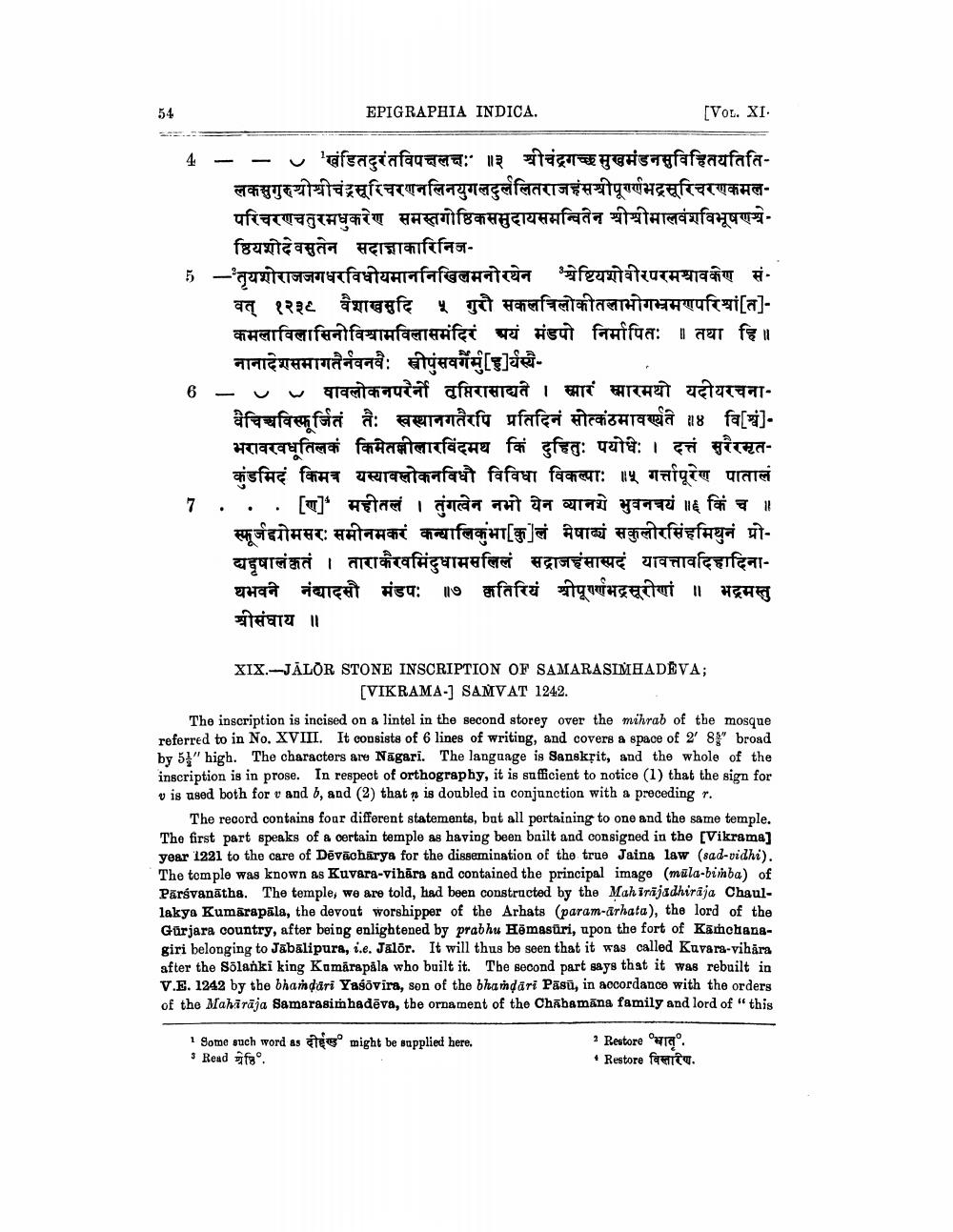________________
54
EPIGRAPHIA INDICA.
[VoL. XI.
4 - - खंडितदुरंतविपक्षलक्षः ॥३ श्रीचंद्रगच्छ मुखमंडनसुविहितयतिति
लकसुगुरुयोश्रीचंद्रसूरिचरणनलिनयुगलदुर्ललितराजहंसश्रीपूर्णभद्रसूरिचरणकमलपरिचरणचतुरमधुकरेण समस्तगोष्ठिकसमुदायसमन्वितेन श्रीश्रीमालवंशविभूषणथे
ष्ठियशोदेवसुतेन सदाज्ञाकारिनिज, -'तृयशोराजजगधरविधीयमाननिखिलमनोरथेन 'वेष्टियशोवीरपरमश्रावकेण सं.
वत् १२३८ वैशाखसुदि ५ गुरौ सकलत्रिलोकीतलाभोगभ्रमणपरिश्रां[त]कमलाविलासिनोविश्वामविलासमंदिरं अयं मंडपो निर्मापितः ॥ तथा हि॥
नानादेशसमागतैनवनवैः स्त्रीपुंसवगैर्मु[]र्यस्यै6 -
पावलोकनपरे! तृप्तिरासाद्यते । स्मारं स्मारमथो यदीयरचनावैचिच्चविस्फूर्जितं तैः स्वस्थानगतैरपि प्रतिदिनं सोत्कंठमावर्ण्यते ॥४ वि[व]भरावरवधतिलकं किमेतल्लीलारविंदमथ किं दुहितः पयोधेः । दत्तं सुरैरमृत
कुंडमिदं किमत्र यस्यावलोकनविधौ विविधा विकल्पाः ॥५ ग पूरेण पातालं 7 . . . [५] महीतलं । तुंगत्वेन नभो येन व्यान भुवनत्रयं ॥६ किं च ॥
स्फूर्जयोमसरः समीनमकरं कन्यालिकुंभा[कुलं भेषाढ्यं सकुलीरसिंहमिथुनं प्रोद्यदृषालंकृतं । ताराकैरवमिंदुधामसलिलं सद्राजहंसास्पदं यावत्तावदिहादिनाथभवने नंद्यादसौ मंडपः ॥७ कतिरियं श्रीपूर्णभद्रसूरीणां ॥ भद्रमस्तु श्रीसंघाय ॥
XIX. - JĀLOR STONE INSCRIPTION OF SAMARASIMHADEVA;
[VIKRAMA-] SAMVAT 1242. The inscription is incised on a lintel in the second storey over the mihrab of the mosque referred to in No. XVIII. It consists of 6 lines of writing, and covers a space of 2 85" broad by 5" high. The characters are Nāgari. The language is Sanskrit, and the whole of the inscription is in prose. In respect of orthography, it is sufficient to notice (1) that the sign for v is used both for v and b, and (2) that n is doubled in conjunction with a preceding r.
The record contains four different statements, but all pertaining to one and the same temple. The first part speaks of a certain temple as having been built and consigned in the [Vikrama] year 1221 to the care of Dëvācharya for the dissemination of the true Jaing law (sad-vidhi). The tomple was known as Kuvara-vihāra and contained the principal image (mala-bimba) of Pārsvanātha. The temple, we are told, had been constructed by the Mahirajadhiraja Chaullakya Kumārapāla, the devout worshipper of the Arhats (param-arhata), the lord of the Gurjara country, after being enlightened by prabhu Hēmasuri, upon the fort of Kāmchanggiri belonging to Jabalipura, i.e.Jalor. It will thus be seen that it was called Kuvara-vihara after the Solanki king Komarapala who built it. The second part says that it was rebuilt in V.E. 1242 by the bhandari Yasovira, son of the bhandari Pasū, in accordance with the orders of the Mahārāja Samarasimhadēva, the ornament of the Chabamāna family and lord of "this
1 Some such word as dee might be sapplied here.
Read ofzo.
Restore भात. • Restore विस्तारण




